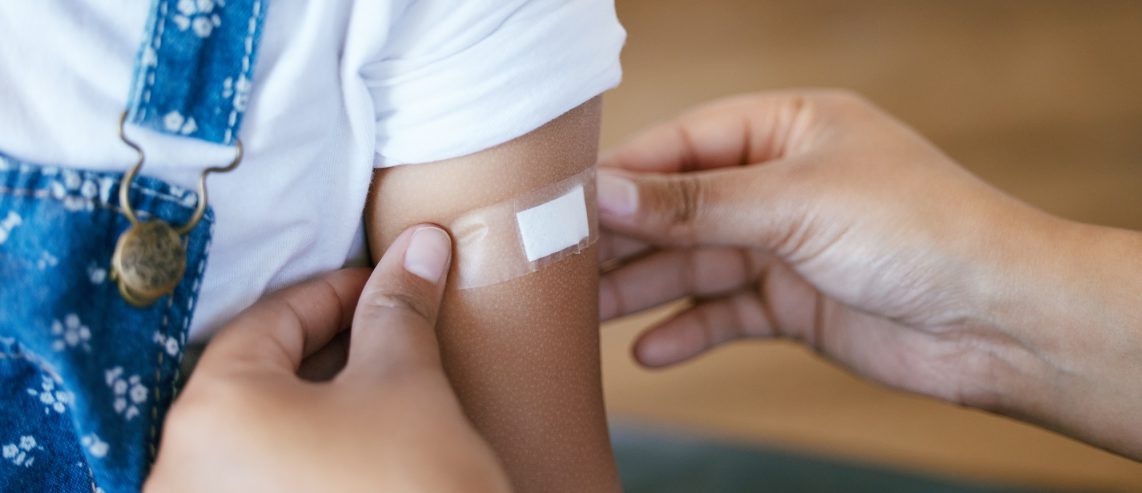You’re sweeping up bits of broken glass and cut yourself. Or you’re slicing a bagel and nick your hand with the knife.
Minor wounds are part of life — and for the most part, you can treat them at home. Here’s how.
How to Treat a Minor Wound
Yes, the sight of blood is often alarming, and even small wounds can hurt a lot. (Think about a paper cut.) But most everyday cuts and scrapes don’t require a trip to the emergency room.
Here’s how to treat a cut.
- Wash your hands with soap and water if possible.
- Stop the bleeding. “With any bleeding, it is important to remain calm, apply continuous pressure, and give it a good one to two minutes. This can feel like a very long time when something hurts, but is usually enough to get the bleeding to stop,” says Martin Johns, MD, Shenango Valley Family Medicine-UPMC.
- Clean the wound by running it under cool or lukewarm water to gently remove dirt or debris. You can use saline solution or a little mild soap to help clean it. “Gentle dish soap works well,” says Dr. Johns.
- Clean the area around the wound with mild soap and a washcloth. Doing so will help prevent infection from germs on the skin.
- “Washing wounds with soap and water is critical to prevent infection when it first occuRs. After the first washing, it is important to avoid getting the wound overly wet and to not scrub the wound open again,” says Dr. Johns.
- Pat the area dry with a clean towel.
- Apply a layer of antibiotic ointment or petroleum jelly to the wound. It will help keep the wound moist for faster healing.
- Cover the wound with a sterile bandage to protect the cut from germs and prevent it from reopening.
- Take over-the-counter pain medication such as acetaminophen.
Never Miss a Beat!
Subscribe to Our HealthBeat Newsletter!
Thank you for subscribing!
You can now select the specific newsletters you'd like to receive.
You are already subscribed.
Subscribe to more newsletters in our email preference center.
Sorry, an error occurred. Please try again later.
Get Healthy Tips Sent to Your Phone!
How to Avoid Infection
To avoid infection, keep the cut clean and change the bandage once a day. You may need to change the bandage more often if it gets wet or dirty.
You should check with your doctor to make sure your tetanus vaccination is up to date. According to the Centers for Disease Control and Infection (CDC), adults need a tetanus booster shot every 10 years. The bacteria that cause tetanus can enter your body through even a small cut.
What to Keep in Your First Aid Kit
Having a well-stocked first aid kit makes treating minor cuts and scrapes easier. You should include these basics in your first aid box:
- Adhesive bandages in a variety of shapes and sizes.
- Several different sizes of gauze rolls.
- Adhesive medical tape.
- Hydrocortisone ointment.
- A cold pack to reduce swelling.
- A breathing barrier (with a one-way valve) for performing CPR.
- Alcohol-free cleansing wipes (such as baby wipes ).
- A digital thermometer.
- Pain medication (acetaminophen, aspirin, or ibuprofen).
- An emergency blanket.
- Cream or spray for insect bites and stings.
- Antiseptic cream.
- Sterile eye pad.
- Safety pins.
- Triangular bandages.
- Disposable gloves.
- Tweezers.
- Scissors.
- Eyewash.
- A felt-tip pen to write down any emergency instructions.
- A first aid manual or booklet.
Be sure to check expiration dates on items in your first aid kit. If someone in your household has a chronic condition (like asthma or diabetes), include an extra inhaler or glucose tablets.
When You Should See a Doctor
There are some wounds you shouldn’t treat at home. Go to the emergency room or call 911 if you have a deep wound or a cut that won’t stop bleeding. Other reasons to see a doctor:
- There’s a foreign object embedded in the wound.
- The wound is close to a major blood vessel.
- The cut has jagged edges or is on a joint.
- The wound came from a human or animal bite.
Call your doctor if you notice any of the following signs or symptoms after treating your minor wound.
- The wound isn’t beginning to heal after a few days.
- The wound continues to bleed.
- You notice signs of infection — swelling, redness, pus, or increasing pain around the wound.
- You have a fever.
- Your glands are swollen.
- You just don’t feel well and can’t pinpoint why.
Most minor cuts heal in a week or less. Taking care of your minor wound will ensure that it heals in the quickest possible time.
Sources
American Academy of Dermatology, How to Treat Minor Cuts, Link
NHS, Cuts and grazes, Link
American Academy of Pediatrics, First Aid Guide for Parents & Caregivers, Link
American Red Cross, Make a First Aid Kit, Link
NHS, What should I keep in my first aid kit? Link
CDC, Must-Haves for Your First-Aid Kit, Link
About UPMC
Headquartered in Pittsburgh, UPMC is a world-renowned health care provider and insurer. We operate 40 hospitals and 800 doctors’ offices and outpatient centers, with locations throughout Pennsylvania, Maryland, New York, West Virginia, and internationally. We employ 4,900 physicians, and we are leaders in clinical care, groundbreaking research, and treatment breakthroughs. U.S. News & World Report consistently ranks UPMC Presbyterian Shadyside as one of the nation’s best hospitals in many specialties and ranks UPMC Children’s Hospital of Pittsburgh on its Honor Roll of America’s Best Children’s Hospitals. We are dedicated to providing Life Changing Medicine to our communities.
